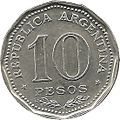This article includes a list of general references, but it lacks sufficient corresponding inline citations .(January 2016) |
| Peso Moneda Nacional (Spanish) | |
|---|---|
| Unit | |
| Symbol | m$n or $+m⁄n |
| Denominations | |
| Superunit | |
| 5 | argentino |
| Subunit | |
| 1⁄100 | centavo |
| Symbol | |
| centavo | ¢ |
| Banknotes | 50 centavos, 1, 5, 10, 50, 100, 500, 1000, 5000, 10000 pesos |
| Coins | 1, 2, 5, 10, 20, 50 centavos, 1, 5, 10, 25 pesos |
| Demographics | |
| Date of introduction | 5 November 1881 |
| Replaced | Argentine real Argentine peso fuerte Argentine peso moneda corriente |
| Date of withdrawal | 1 January 1970 |
| Replaced by | Argentine peso ley |
| User(s) | Argentina |
| Issuance | |
| Central bank | Banco Central de la República Argentina |
| Website | www |
| This infobox shows the latest status before this currency was rendered obsolete. | |
The Peso Moneda Nacional (symbol: m$n), or simply peso, was the first unified national currency of Argentina. It was used from 5 November 1881 to 1 January 1970, the date in which the peso ley 18.188 was issued to the Argentine public. It was subdivided into 100 centavos, with the argentino worth 5 pesos. The peso was introduced to replace the Argentine peso moneda corriente at a rate of $+m⁄c 25 = m$n 1.



























































